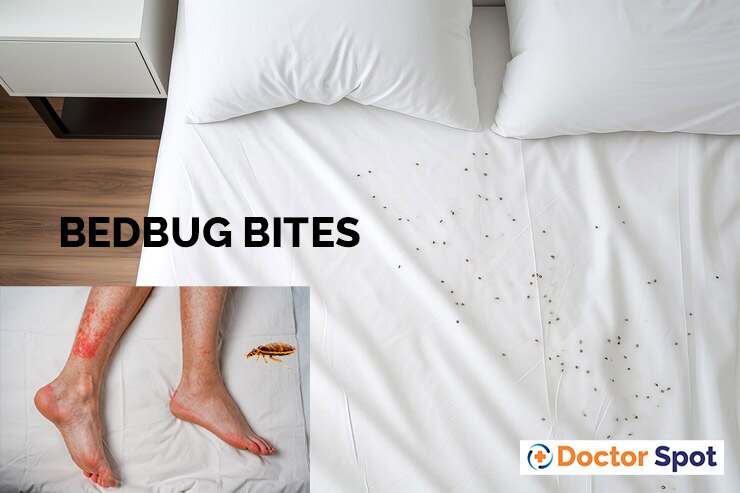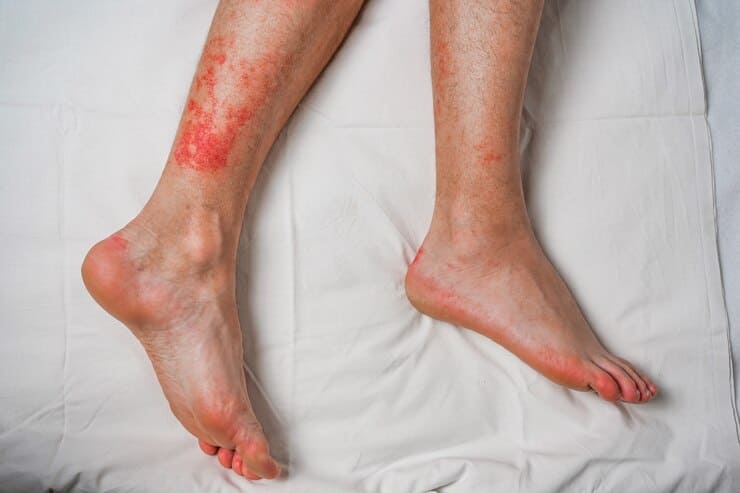Bedbug Bites : Symptoms and causes, Identification, Prevention, Treatment

Imagine, for a moment, waking up to find small, itchy red bumps on your skin. You scratch your head, wondering where they might have come from. Unbeknownst you, a small but fierce intruder was at work while you slept—a bedbug. Bedbugs have been the source of significant discomfort and stress for countless individuals. In this article, we’ll delve into the world bedbugs, focusing specifically on bedbug bites, how to identify them, their effects on health, and effective methods to manage and prevent them.
The Mysterious Bedbug: A Brief Overview
Bedbugs are small, wingless insects that feed exclusively on the blood of warm-blooded animals. While they prefer human hosts, they’ll also bite other mammals and birds. Here are some quick facts about bedbugs:
-
Size and Appearance: Adult bedbugs are about the size of an apple seed—roughly 5-7 mm long. They are brownish-red and turn a deeper red after feeding.
-
Behavior and Habitat: Bedbugs are nocturnal and often hide in mattress seams, headboards, bed frames, and other dark, small crevices.
-
Lifecycle: Bedbugs go through several life stages, from eggs to nymphs to adults. A female bedbug can lay hundreds of eggs in her lifetime.
Now that we have a basic understanding of what bedbugs are, let’s dive deeply into how their bites affect us.
Identifying Bedbug Bites: What to Look For
One of the most challenging aspects of dealing with bedbugs is correctly identifying their bites. Unlike mosquito bites, which are often immediate and identifiable, bedbug bites can be more elusive. Here are some specific characteristics:
Common Symptoms
-
Red Welts: Bedbug bites often appear as small, red welts on the skin.
-
Itchiness: These bites are usually very itchy and can become more inflamed with scratching.
-
Bite Pattern: Unlike other insect bites, bedbug bites often appear in clusters or lines, commonly referred to as “breakfast, lunch, and dinner” due to their feeding pattern.
-
Time of Appearance: Bites may not appear immediately. It can take up to several days for symptoms to show up.
Differentiating from Other Bites
Bedbug bites can be confused with other insect bites or skin conditions. Here are some tips to differentiate:
-
Mosquito Bites: Generally larger and more singular compared to the clustered pattern of bedbug bites.
-
Flea Bites: Typically found around the lower legs and ankles, whereas bedbug bites can occur anywhere on the body.
-
Allergic Reactions: Skin rashes or conditions like hives can sometimes be mistaken for bedbug bites. Pay attention to other symptoms like swelling, difficulty breathing, or a widespread rash.
The Health Impact of Bedbug Bites
While bedbug bites themselves are not typically dangerous, they can have several impacts on physical and mental health. Here are some concerns you should be aware of:
Physical Health Effects
-
Skin Infections: Constant scratching can lead to open sores, increasing the risk of secondary bacterial infections.
-
Allergic Reactions: Some individuals may experience allergic reactions to bedbug bites, leading to more severe symptoms like swelling or blistering.
-
Sleep Disturbances: The itchiness and anxiety caused by bedbug bites can significantly affect sleep quality, leading to issues like insomnia.
Mental Health Effects
-
Stress and Anxiety: The mere thought of bedbugs can cause considerable stress and anxiety. The fear of being bitten while you sleep can be overwhelming.
-
Embarrassment and Social Stigma: Unfortunately, there’s a social stigma associated with bedbugs, leading some individuals to feel embarrassed or ashamed.
-
Chronic Stress: Ongoing issues with bedbugs can lead to chronic stress, which can have far-reaching effects on overall well-being.
Confirming Bedbug Infestation
Identifying bedbug bites is only part of the battle. To address the issue effectively, you need to confirm whether you have a bedbug infestation. Here are some steps to take:

Visual Inspection
-
Look for Bedbugs: Check mattress seams, headboards, and other crevices for live bedbugs.
-
Eggs and Nymphs: Besides adult bedbugs, look for eggs and nymphs (young bedbugs), which are smaller and lighter in color.
-
Fecal Spots: Bedbugs leave behind small, dark spots of fecal matter, often on sheets and mattresses.
-
Exoskeletons: Bedbugs shed their skin as they grow. Finding these shed skins is another sign of infestation.
Professional Inspection
If you’re finding it difficult to confirm on your own, consider hiring a pest control professional. They have specialized tools and the experience needed to accurately identify and address bedbug infestations.
Treating Bedbug Bites: Immediate Relief
Once you’ve confirmed bedbug bites, the next step is to alleviate the symptoms. Here are some effective home remedies and medical treatments:
Home Remedies
-
Cold Compress: Applying a cold compress can help reduce itchiness and swelling.
-
Oatmeal Baths: Oatmeal has soothing properties that can alleviate itching. Add some oatmeal powder to your bath for relief.
-
Aloe Vera: Known for its soothing and anti-inflammatory properties, aloe vera gel can be applied directly to the bites.
-
Baking Soda Paste: Make a paste from baking soda and water and apply it to the bites for relief.
Over-the-Counter Treatments
-
Antihistamines: Oral antihistamines like diphenhydramine (Benadryl) can help reduce itching and swelling.
-
Hydrocortisone Cream: This can be applied to the bites for itch relief and to reduce inflammation.
-
Antibiotic Ointment: If you have scratched the bites and developed open sores, applying an antibiotic ointment can prevent bacterial infections.
Professional Medical Help
While home remedies and over-the-counter treatments work for most, consult a healthcare provider if you experience severe reactions or signs of infection, such as:
-
Increased pain, redness, or swelling
-
Pus or drainage from the bites
-
Fever or chills
Long-Term Management: Preventing Bedbug Infestations
Treating bedbug bites is essential, but long-term management requires addressing the infestation itself. Here are some strategies to prevent and manage bedbug infestations:
Home Cleanliness
-
Regular Vacuuming: Vacuum your home regularly, paying close attention to carpets, mattress seams, and furniture.
-
Wash Bedding: Frequently wash your sheets, pillowcases, and blankets in hot water.
-
Declutter: Reduce clutter around your home to eliminate potential hiding spots for bedbugs.
Protective Measures
-
Mattress Encasements: Use specially designed mattress and box spring encasements to trap bedbugs and prevent them from hiding in your bed.
-
Seal Cracks and Crevices: Seal any cracks and crevices in walls, furniture, and bed frames where bedbugs could hide.
-
Inspect Second-Hand Furniture: Be cautious when buying second-hand furniture. Thoroughly inspect it before bringing it into your home.
Professional Pest Control
Sometimes, professional intervention is necessary for effectively getting rid of bedbugs:
-
Pesticides: Pest control professionals may use pesticides specifically designed to kill bedbugs.
-
Heat Treatments: Another effective method involves raising the temperature in your home to a level that kills bedbugs and their eggs.
-
Follow-Up Inspections: Multiple treatments may be needed to eradicate bedbugs entirely. Follow-up inspections can ensure that the infestation has been successfully addressed.
Debunking Common Myths About Bedbugs
There’s a lot of misinformation out there when it comes to bedbugs. Let’s clear up some common myths:
Myth #1: Bedbugs Only Infest Dirty Homes
Reality: Bedbugs can infest any environment, clean or dirty. They are solely focused on their needs for food and hiding spots.
Myth #2: Bedbugs Transmit Disease
Reality: Unlike some other pests, bedbugs are not known to transmit diseases to humans. However, their bites can cause itching and secondary infections if not properly cared for.
Myth #3: You Can’t See Bedbugs
Reality: While they are small, bedbugs are visible to the naked eye. Adults are about the size of an apple seed, and you can also see their eggs and nymphs with careful inspection.
Myth #4: Bedbugs Only Live in Beds
Reality: Although they’re often associated with beds, bedbugs can live anywhere in the home, including furniture, baseboards, electrical outlets, and even behind wallpaper.
Conclusion: Taking Control of the Situation
Dealing with bedbug bites and infestations can be an overwhelming experience. Understanding how to identify bites, mitigate their health impacts, and effectively manage an infestation are crucial steps in regaining control. Remember, if you’re struggling to handle the situation on your own, don’t hesitate to seek professional help.
“Knowledge is power. The more informed you are about bedbugs and their bites, the better equipped you’ll be to handle and prevent infestations.”
By following the tips outlined in this article, you’ll be well on your way to a bedbug-free environment and a restful night’s sleep. So, arm yourself with this information and take proactive steps to ensure your home remains a sanctuary, free from these unwelcome intruders.